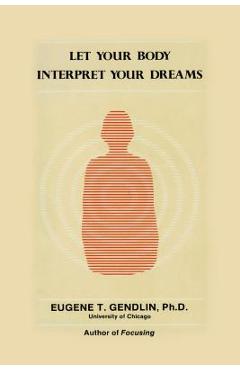Let Your Body Interpret Your Dreams (P) - Eugene T. Gendlin

Detalii Let Your Body Interpret Your
libris.ro
163.3 Lei
181.45 Lei
Self-help
Eugene T. Gendlin
Let Your Body Interpret Your - Disponibil la libris.ro
Pe YEO găsești Let Your Body Interpret Your de la Eugene T. Gendlin, în categoria Self-help.
Indiferent de nevoile tale, Let Your Body Interpret Your Dreams (P) - Eugene T. Gendlin din categoria Self-help îți poate aduce un echilibru perfect între calitate și preț, cu avantaje practice și moderne.
Preț: 163.3 Lei
Caracteristicile produsului Let Your Body Interpret Your
- Brand: Eugene T. Gendlin
- Categoria: Self-help
- Magazin: libris.ro
- Ultima actualizare: 28-10-2025 01:22:05
Comandă Let Your Body Interpret Your Online, Simplu și Rapid
Prin intermediul platformei YEO, poți comanda Let Your Body Interpret Your de la libris.ro rapid și în siguranță. Bucură-te de o experiență de cumpărături online optimizată și descoperă cele mai bune oferte actualizate constant.
Descriere magazin:
A Profound Method to Work with Dreams In research at the University of Chicago, Dr. Gendlin found that certain specific bodily responses can open up and lead to small steps of a new experience. These bodily responses can indicate the steps for interpreting a dream. Theories about dreams differ and give contradictory interpretations. Dr. Gendlin derives 16 questions from the many existing theories to aid you, the dreamer, in. the process of interpretation. In this book Dr. Gendlin teaches you to ask the questions so that your body can respond . You learn to recognize how it feels when a question is about to lead to a breakthrough. You learn to let the question complete itself so that the dream opens and you know without doubt what it is about. The first stage is learning what the dream is about. But this alone may not yet tell you anything you did not know before. The second stage is getting something new from the dream for your own development. The BIAS CONTROL solves what was, until now, an insurmountable problem: People could not interpret their own dreams because they always imposed their usual biases on them. The BIAS CONTROL shows you how to open yourself to a new step. Eugene T. Gendlin, Ph.D., is Professor of Psychology at the University of Chicago. He has written books and articles in philosophy and psychology. His work has been translated into more than seven languages. He was for many years the editor of Psychotherapy: Theory, Research, and Practice. In 1970 he was chosen by the Psychotherapy Division of the American Psychological Association for their first Distinguished Professional Psychologist of the Year Award.

Produse asemănătoare

Let Your Body Interpret Your Dreams (P) - Eugene T. Gendlin
![]() libris.ro
libris.ro
Actualizat in 28/10/2025
163.3 Lei

Every Body Yoga: Let Go of Fear, Get on the Mat, Love Your Body., Paperback/Jessamyn Stanley
![]() elefant.ro
elefant.ro
Actualizat in 28/10/2025
108.99 Lei

The New Rules of Pregnancy: What to Eat, Do, Think About, and Let Go of While Your Body Is Making a Baby, Hardcover/Adrienne L. Simone
![]() elefant.ro
elefant.ro
Actualizat in 28/10/2025
122.99 Lei

Neuroslimming. Let Your Brain Change Your Body, Paperback/Dr Helena Popovic
![]() elefant.ro
elefant.ro
Actualizat in 28/10/2025
122.99 Lei

Mind Over Meds: Know When Drugs Are Necessary, When Alternatives Are Better-And When to Let Your Body Heal on Its Own - Andrew Weil
![]() libris.ro
libris.ro
Actualizat in 28/10/2025
111.55 Lei
Produse marca Eugene T. Gendlin

Let Your Body Interpret Your Dreams (P) - Eugene T. Gendlin
![]() libris.ro
libris.ro
Actualizat in 28/10/2025
163.3 Lei



